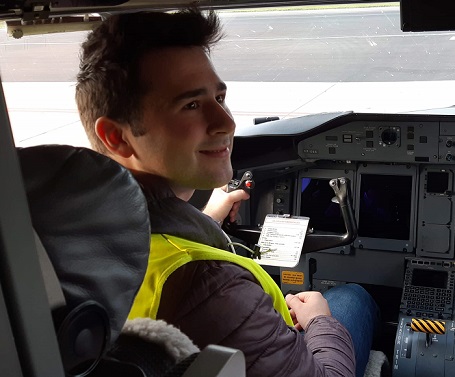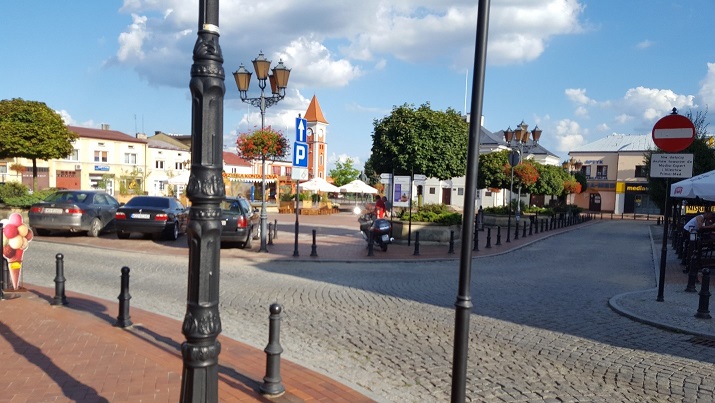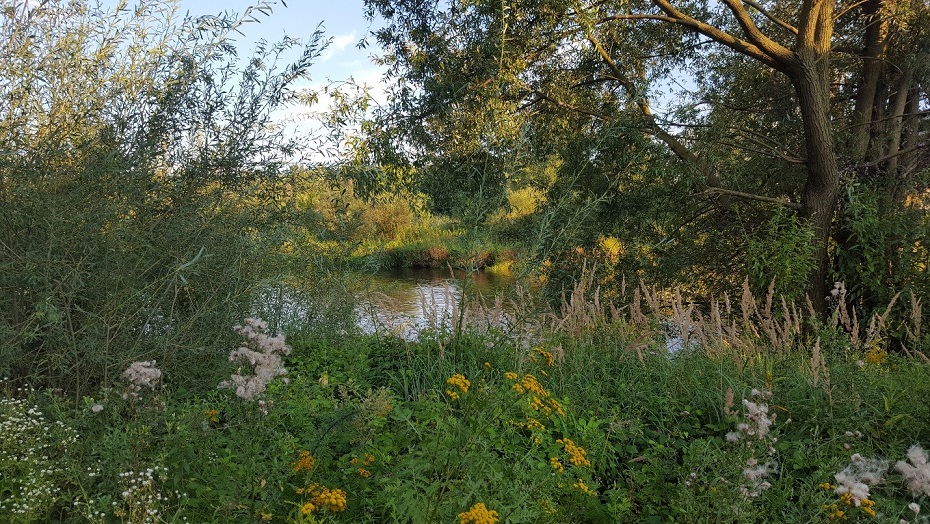A Tale of Two Stetlach

In my previous post, I described visiting the sites of my great-great grandparents’ homes in the city of Warsaw while attending a conference there. But in fact, the story goes much further. As I mentioned last time, when researching my grandfather’s grandparents, I found their marriage record from 1894. In previous articles, I described how I was able to use it as a springboard to reconstruct a history of many branches of this part of my family.
It turns out that the bride’s father’s family had already been living in Warsaw for at least 70 years, perhaps significantly longer, by the time of the wedding in 1894. Her paternal grandfather Moshek Krzak, a wagon driver from Warsaw, married a woman named Sheindl Brant in 1823. According to that documentary evidence, Sheindl was from a town called Warka, and their marriage took place there. As it happens, Warka is only about thirty miles south of Warsaw. I was just dying to pay a visit!

Preparing for My Journey
Looking at a map of the Polish train system, I saw that there was a local commuter train that went from Warsaw to Warka. An excursion was definitely in order! When I asked the concierge at the conference hotel how to find out what time the trains stopped running run at night, I ended up telling him that I planned to go to Warka. He responded that I must really love beer. Seeing my confusion, he told me that one of the biggest and most famous beer breweries in Poland is located in that town, and the beer it produces is simply called “Warka.” He looked it up online and found that it had been established over 650 years ago.
When I told him that I just wanted to see the town itself and not the brewery, he looked as confused as I had only moments before. I explained to him that my ancestors had come from that town and that I wanted to see where they lived. After we cleared up the confusion, he looked up the train schedules for me.
The Trip Begins
 After we looked up the train schedules online and I was reassured that there was no possibility of ending up stranded, I took a trolley to the center of town (Śródmieście), went to the main commuter train station, and bought my tickets. In the train hall, I saw a local couple waiting around. I asked them which platform had the train to Warka, and it turned out they were taking the same train as me. We ended up getting into an interesting conversation, waiting for the train together, and sitting together until we reached their stop.
After we looked up the train schedules online and I was reassured that there was no possibility of ending up stranded, I took a trolley to the center of town (Śródmieście), went to the main commuter train station, and bought my tickets. In the train hall, I saw a local couple waiting around. I asked them which platform had the train to Warka, and it turned out they were taking the same train as me. We ended up getting into an interesting conversation, waiting for the train together, and sitting together until we reached their stop.
The guy, Łukasz, is a talented student of aeronautical engineering. The girl, Julia, is studying systems analysis, and is actually from Russia. It turns out that they had both studied German in high school and won the opportunity to study at an extremely prestigious program in Germany, which is how they knew one another. She was visiting him here in Warsaw, and they were on their way to introduce her to his parents. I shared a bit about myself with them, showed them some of my research and family documents, and explained what I was doing in Warsaw and Warka. They both seem like interesting, engaging, and open-minded young individuals; we exchanged contact information and have kept in touch ever since. They got out six stops before mine, so I finished the rest of my journey in solitude, lost in thought.
A First Arrival
When I arrived in Warka, I found that the train station was about one and a half miles outside of the center of town. Following the main road into town, I eventually reached the main square. At the pierogi restaurant where I ate lunch, I told the waitress that my family had lived in this town two hundred years ago; she reacted in wide-eyed astonishment and welcomed me to the town.
 Warka itself is a descent sized typical suburban town; the main square has primarily modern buildings that were newly constructed after the war. On the main street are ice cream shops, restaurants, and a souvenir shop where I bought three refrigerator magnets—one for my grandfather, one for my father, and one for me. The more people I told about my family, the more looks of wide-eyed astonishment and welcoming greetings I received.
Warka itself is a descent sized typical suburban town; the main square has primarily modern buildings that were newly constructed after the war. On the main street are ice cream shops, restaurants, and a souvenir shop where I bought three refrigerator magnets—one for my grandfather, one for my father, and one for me. The more people I told about my family, the more looks of wide-eyed astonishment and welcoming greetings I received.
From the main square, I walked to the old Jewish cemetery, about two miles outside of town in the opposite direction as the train station. The cemetery was on the top of a hill overlooking a beautiful stream. Climbing the derelict old staircase, I mused at how my own ancestors must have done tashlich services two centuries ago at this very stream, perhaps to this very spot. Although nothing remains of the actual cemetery save a recently-erected tombstone, I was standing in a place that undoubtedly had been an integral part of their lives.
When attempting to find the cemetery, I met a friendly, helpful couple with their two-year-old daughter. In fact, I would never have been able to find the cemetery had they not told me where it was. They even guided me to it. They had been living in Britain and spoke perfect English, so we got into a conversation. They also offered to drive me back to the station, saving me over an hour of walking.

After returning to Warsaw, I went that evening to a convenience store around the corner from my hotel. My curiosity aroused, I bought a Warka beer, and was happy to discover that it was astonishingly good!
Another Day, Another Journey
The day after the conference ended, I rented a car to visit archives in Włocławek to do research at an archive. After I achieved my primary purpose and unearthed a document that ended up yielding major discoveries, I decided to do some more exploring.
 The 1894 marriage record told me the name of my great-great grandfather’s mother. Some more detective work led me to discover that my great-great grandfather’s mother was born in a town called Radziejow. In fact, I have traced my family back to around the year 1800 in the town, about a hundred miles west of Warsaw. Naturally, this was my next stop after leaving the archive.
The 1894 marriage record told me the name of my great-great grandfather’s mother. Some more detective work led me to discover that my great-great grandfather’s mother was born in a town called Radziejow. In fact, I have traced my family back to around the year 1800 in the town, about a hundred miles west of Warsaw. Naturally, this was my next stop after leaving the archive.
Unlike Warka--a very modern town not altogether unlike Morristown, New Jersey or Pasadena, California--Radziejow appeared almost frozen in time. Far off the beaten track, it is quiet and far smaller. In fact, the word “stetl” brings to mind images of places that are almost exactly like this.
In the main part of town, hundred-year-old buildings surround the central square. Dodging raindrops, I could picture the horse-drawn carriages roaming the streets in my mind’s eye. Other than the modern automobiles and electrical wiring, it can seem for a few moments like not much has changed since the days when my great-great-great grandmother walked these streets. Between the raindrops, you can almost hear the ghosts of the past.
To Each, Their Own Journey
Having the opportunity to travel in my ancestor’s footsteps—to visit the very places they walked, prayed, and went about their lives—was an opportunity I will never forget. The chance to touch the places they touched was an unbelievably moving experience.
Are you interested in taking a similar journey? Would you like to find out where your ancestors are from so that you can walk the streets they walked, touch the stones they touched, see the sights they saw? At Lost Roots Family History, our research may be able to provide you with similar experience for your ancestral villages, towns, and cities. Please visit our website at www.lostrootsfamilyhistory.com to learn more, or feel free to contact me at 1-888-96LOSTRTS (1-888-965-6787) or at https://lostrootsfamilyhistory.com/contact.

Add new comment